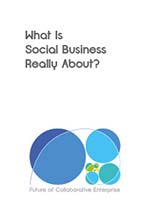Michael Wu, Scientist of Analytics at Lithium, has posted a great article upon the different components defining the strength of a Relationship.
The notion of tie strength was first introduced in 1973 by Prof. Mark Granovetter in his seminal work: The Strength of Weak Ties. He identified four different components of tie strength.- Time: amount of time spent together
- Intensity: emotional intensity and the sense of closeness
- Trust: intimacy or mutual confiding
- Reciprocity: amount of reciprocal services
In his post, he details how companies can leverage their relationships with customers through the analysis of these four components. Nevertheless, there is in my opinion another component, which underlies any relationship, which shouldn’t be ignored in this framework: its direction. Like magnets attract or repel each other, relationships are either positive or negative, and this has a deep impact on other components as well.
This isn’t a matter of love and hate, since those both sentiments, when applied to an individual, share in fact a lot of similarities, and we can find more than a few case studies explaining how brands’ more virulent detractors might be turned into ambassadors. (Group hatred obeys to different mechanisms, but here too, these mechanisms are quite close to those driving empathy in groups). Both can be considered as “positive” relationships.
“Negative” relationships, on the other side, are driven by sentiments like disgust, fear, or conscious avoidance. Typically, people maintaining this kind of relationships with brands are to be found among non-customers. Non-customers who might have been customers before, or who might never have been but have built a distorted image of brands, this for a lot of reasons.
I remember my father who, when wanting to choose and buy some household appliance, systematically dismissed products from one famous brands. Some of his justifications were, of course, highly irrational, but he also had some very good points. So good, in fact, that, if the brand had heard about, this could have lead to real products improvements.
Listening to your non-customers is not an easy task. They don’t speak about you, they don’t interact with you, but they don’t ignore you; they are just staying away from any of your attempts to meet their expectations. They don’t eventually gather into communities. They have low, if any, expectations for your brand. But these non-customers are the ones who might give you the more clues about how to serve them better.





